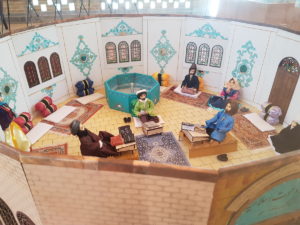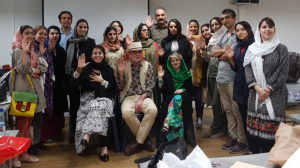
I was in Isfahan for the General Assembly of the World Crafts Council, where I was representing my country of birth, Australia. I had to pay my own way, but I thought this was a unique opportunity to be shown around city claimed to be “half the world”. Looking at the press coverage during the event, it was clear that Iranians were seeing this as the first major international gathering since the lifting of sanctions. There seemed much at stake in welcoming the world to this legendary city of craft.
We were assigned guides to help us appreciate the city. On the way to the Isfahan Bazaar, we passed by a mysterious museum with photographs of early twenty-first century Iran. In the first room was a tiled world with the inevitable floral ornament, interspersed with images of religious figures and fascinating accounts (in English) of the Constitutional Movement of 1906 in Iran. My guide told me that Mullahs gathered in this house, known then as the Safa Khaneh, to read newspapers, from which they disseminated the move to replace the absolute power of the Shah with a democratically elected government.
A diorama in the centre of the room caught my eye. It featured two men sitting opposite each other. One was dressed as a Mullah, and the other as a Christian priest. Around them was a mix of Muslim and Christian men and women. I learnt that during this time there were open dialogues between the two religious. They were conducted in order to forge an understanding of Iran as a tolerant nation that embraces other religions of the book. So Iranians valued religious tolerance too!
In the intensive Googling that followed, I discovered that this moment was celebrated by the Iranian President Mr Mohammed Khatami, when he launched the concept of a Dialogue among Civilisations in 1998. This idea reached its greatest potential when taken up as the official theme of 2001 by the United Nations. His speech to launch contained this amazing passage:
“In addition to poetic and artistic experience, mysticism also provides us with a graceful, profound and universal language for dialogue. Mystical experience, constituted of the revelation and countenance of the sacred in the heart and soul of the mystic, opens new existential pathways on to the human spirit.”
I’m still trying to get my head around Persian mysticism. Through stilted English translations of poems by Hafez, I can occasionally glimpse the layers of meaning that Iranians have grown to see in the world. And I remember the Elephant in the Dark exhibition organised by Iranians in Melbourne, based on a tale of people imagining different animals from the particular part of the elephant they could feel in the dark.
2001… It was hardly an auspicious year to launch a Dialogue among Civilisations. But at least it became an idea, which will hopefully have a better day to come.
After Isfahan, I spent some days in Tehran with the Mahe Mehr Art and Culture Institute, which is a wonderful art academy established by three visionary gallerists to help improve the thinking and techniques in the local art scene. I offered to give a workshop on the Social Object, with a particular focus on the “promise object”. When I sought they ideas about where trust was lacking in contemporary Iran, a large number mentioned relations with minority religions. So we developed some objects that might help sow seeds for a better understanding between these faiths.
Their concerns reflected the experience in Australia after the Martin Plaza hostage crisis, when so many used the hashtag #IllRideWithYou to show support for Muslim women who might be afraid of Islamophobia. These “memes” mean well, but they are not good at creating ongoing structures for solidarity.
This time in Tehran there was intense interest in the promise object. We had to do the workshop again due to the demand. During the week at Mahe Mehr, I was impressed by how much these (mostly jewellery) artists were very keen to learn more about the cultural scenes outside Iran, and particularly how to engage with them. I was lucky to be there for a ground-breaking exhibition of 60 jewellers who made work about living in Tehran. The quality and ideas behind their work was amazing.
Craft generally is a powerful way of connecting cultures that are otherwise opposed ideologically. It’s a shared human story of how we’ve made something from the corner of the world where we live. Jewellery in particular is a powerful link as a form of personal ornament that connects us as individuals. It’s modernist phase is relentlessly democratic in critiquing the role of jewellery in sustaining hierarchy, from royal crowns to Debeers diamond rings. Through the AJF Ambassadors program, we are now expanding the field to reflect the new perspectives brought by jewellery scenes outside the trans-Atlantic north.
One young jeweller came up with the idea of extending the act of promise to people of other countries. This would be a version of a free trade agreement, except in this case it would be between individuals, along the lines of “I’ll protect your religion, if you’ll protect mine.” How would people make this connection? In one of the bazaars I’d seen posters warning of the dangers of Facebook, which is officially banned in Iran. However, as artists, most of them were on Instagram, which is not banned. This seemed a good platform where individuals from East and West could connect.
One of the writers present spoke about the Tirgan festival, which is a Zoroastrian event that celebrates the coming of rains at the end of summer. Tirgan tells the story of Arash, an archer chosen to mark the boundaries Persian and the Central Asian kingdom of Turan. Shot from Mount Damavand’s peak, his arrow landed on the banks of a river that marked the permanent border, and thus bringing in an era of peace between the two kingdoms. This was followed by welcome rains. We could think of people using the platform to send missives between East and West, exploring similarities and differences. Tirgan also has a jewellery link. It is celebrated by wearing a rainbow coloured bracelet for 10 days, which is then cast into the waters.
While Tirgan seemed a perfect story for our project, eventually there was concern that there could be problems for anyone linked to a project that is formally identified with Zoroastrianism. So right now Tirgan functions more as a backstory, but we do hope to include the bracelets for an event with the Radiant Pavilion jewellery festival in Melbourne this August.
The initial version of the platform exists now on Garland – www.garlandmag.com/east-west-meet. Please enter your details to be linked to someone on the other side. It will be carefully monitored to ensure that people treat this respectfully. We can follow its progress with the hashtag #eastwestmeet.
Most of what’s happening in the world is beyond our control. We hope that East West Meet is something that appeals as a form of direct action. There are many hopes pinned on it.
Also published on Medium.



